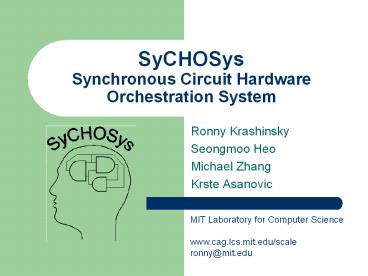Ronny Krashinsky - PowerPoint PPT Presentation
Title:
Ronny Krashinsky
Description:
Determine energy usage (Joules) Investigate SW, compiler, and architecture changes ... SyCHOSys can accurately simulate the energy usage of a CPU circuit at speeds on ... – PowerPoint PPT presentation
Number of Views:45
Avg rating:3.0/5.0
Title: Ronny Krashinsky
1
SyCHOSysSynchronous Circuit Hardware
Orchestration System
- Ronny Krashinsky
- Seongmoo Heo
- Michael Zhang
- Krste Asanovic
MIT Laboratory for Computer Science www.cag.lcs.m
it.edu/scale ronny_at_mit.edu
2
Motivation
- Given a proposed processor architecture, we want
to - Simulate performance (cycle count)
- Determine energy usage (Joules)
- Investigate SW, compiler, and architecture changes
Existing simulators Prohibitively slow or
inaccurate
3
SyCHOSys
- SyCHOSys generates compiled cycle simulators
- Can optionally track energy usage
- Exploits low power microprocessor design domain
to obtain accurate transition-sensitive energy
models - Factors out common transition counts
- Uses fast bit-parallel transition counting
- 7 orders of magnitude faster than SPICE (7
error) - 5 orders of magnitude faster than PowerMill
SyCHOSys can accurately simulate the energy usage
of a CPU circuit at speeds on the order of a
billion cycles per day
4
Overview of talk
- SyCHOSys Framework
- Microprocessor Energy Modeling
- Energy Simulation in SyCHOSys
- Results
- Status Future Work
5
SyCHOSys Framework
6
SyCHOSys Framework
GCD(x, y) if (x lt y) return GCD(y, x)
else if (y!0) return GCD(x-y, y) else
return x
7
SyCHOSys Framework
X N-CLK FF_Enlt32gt (NextX.out, Ctrl.Xen) Y
N-CLK FF_Enlt32gt (X.out, Ctrl.Yen)NextX
Mux2lt32gt (Y.out, XSubY.out, Ctrl.XM
uxSel)XSubY H-DYNAM Sublt32gt
(X.out, Y.out)Yzero H-DYNAM Zerolt32gt
(Y.out)YZeroL H-LATCH Latchlt1gt
(YZero.out)XLessYL H-LATCH Latchlt1gt
(XSubY.signbit)Ctrl GCDCtrl
(XLessYL.out, YZeroL.out)
Structural Netlist
Cycle Scheduler
Additional Simulator Code
Scheduled Component Evaluations
Component Behavioral Methods
gcc
Cycle-based Simulator
8
SyCHOSys Framework
Structural Netlist
templateltint bitsgtclass Mux2 inline void
Evaluate( BitVecltbitsgt input0,
BitVecltbitsgt input1, BitVeclt1gt select)
if (select) out input1 else out
input0 BitVecltbitsgt out
Cycle Scheduler
Additional Simulator Code
Scheduled Component Evaluations
Component Behavioral Methods
gcc
Cycle-based Simulator
9
SyCHOSys Framework
GCDclock_rising()
Structural Netlist
GCDclock_high() YZero.Evaluate(Y.out)
YZeroL.Evaluate(YZero.out) XSubY.Evaluate(X.out
, Y.out) XLessYL.Evaluate(XSubY.signbit)
Ctrl.Evaluate(XLessYL.out,
YZeroL.out) NextX.Evaluate(Y.out, XSubY.out,
Ctrl.XMuxSel)
Cycle Scheduler
Scheduled Component Evaluations
Additional Simulator Code
Component Behavioral Methods
gcc
Cycle-based Simulator
GCDclock_falling() Y.Evaluate(X.out,
Ctrl.Yen) X.Evaluate(NextX.out, Ctrl.Xen)
GCDclock_low() YZero.Precharge()
XSubY.Precharge() NextX.Evaluate(Y.out,
XSubY.out, Ctrl.XMuxSel)
10
SyCHOSys Framework
Structural Netlist
Cycle Scheduler
void gcd_clock_tick() gcd-gtclock_rising()
gcd-gtclock_high() gcd-gtclock_falling()
gcd-gtclock_low()
Additional Simulator Code
Scheduled Component Evaluations
Component Behavioral Methods
gcc
Cycle-based Simulator
11
SyCHOSys Framework
Structural Netlist
Cycle Scheduler
Scheduled Component Evaluations
Additional Simulator Code
Component Behavioral Methods
- Optimizing compiler
- Component evaluation calls are inlined
gcc
Cycle-based Simulator
12
Energy Modeling
- Power consumption in digital CMOS
- Dynamic Switching
- Short Circuit Current
- Leakage Current
13
Energy Modeling
- Power consumption in digital CMOS
- Dynamic Switching around 90
aCloadVSWINGVDDf
14
Energy Modeling
- Power consumption in digital CMOS
- Dynamic Switching around 90
aCloadVSWINGVDDf
We simplify our task by taking advantage of our
restricted domain of well designed low power
microprocessors
15
Microprocessor Energy
- Energy usage in a microprocessor
- Memory arrays
- Datapaths
- Control
16
Microprocessor Energy
- Energy usage in a microprocessor
- Memory arrays
- Datapaths
- Control
- Extremely regular
- Calibrate models with several test cases
- Accounts for partial voltage swings, effective
capacitance values, etc. - Estimate energy based on cycle by cycle address
and data trace (3 error)
17
Microprocessor Energy
- Energy usage in a microprocessor
- Memory arrays
- Datapaths
- Control
18
Effective Load Capacitance
SPACE 2D extractor
- Gate and Drain Capacitance Models
- Characterized using FO4 delays and rise/fall times
MergeCap
19
Microprocessor Energy
- Energy usage in a microprocessor
- Memory arrays
- Datapaths
- Control
- Synthesized using automated tools Irregular,
hard to model - Less than 10 of energy in simple RISC designs
- Will become more important in low power designs
- Can be modeled at the level of standard cell
gates - Work in progress
20
SyCHO Energy Analysis
21
SyCHO Energy Analysis
22
SyCHO Energy Analysis
23
Energy-Performance Model Evaluation
- Used GCD circuit as an example datapath
- Various component types
- (Flip-Flops, Latches, Dynamic)
- Small enough for SPICE simulation
- Hand-designed layout (0.25 mm TSMC)
24
Simulation Speed
- All tests run on 333 MHz Sun Ultra-5 (Solaris 2.7)
25
Energy Simulation Results
26
Status Future Work
- Microprocessor simulation
- Five stage MIPS RISC including caches and
exception handling - Runs SPECint programs
- Most of energy modeling is complete
- Energy simulation of over 2000 nodes at 16 kHz
- Future Work
- Short circuit leakage current modeling
- Control logic modeling
- Take energy statistics per static program
instruction - Incorporate SyCHOSys into VLSI tool flow






























